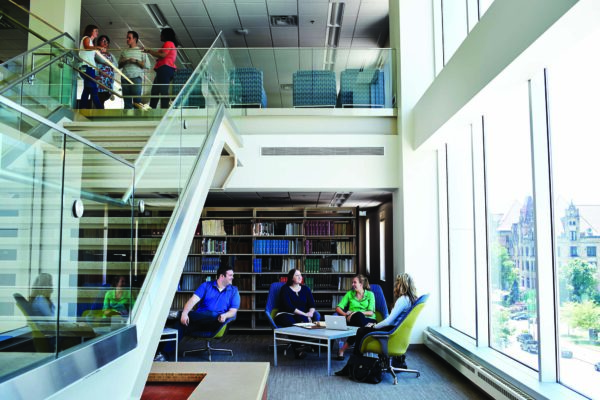By John Marx
John Marx is blogging about his year in the ACE Fellows Program in a series of posts centered on the idea of “place” in American higher education leadership. Marx, professor and chair of the English Department at University of California, Davis, is spending his year working with President Elizabeth Hillman at Mills College in Oakland, California.
Contrary to the notion that colleges and universities are valuable to the extent they are autonomous—the work of teaching and research kept at one remove from the larger world—presidents and chancellors of urban institutions are finding advantages in forging local partnerships.
Institutions of higher education nearly always have considerable impact on their surroundings—they are major employers and property owners, so how could they not? An increasing number of city colleges and universities are being more deliberate about how they affect their neighbors, and in the process clarifying their social value through civic engagement.
Being an institutional anchor for a neighborhood or region is hard work though, and the colleges and universities most engaged with their cities are also discovering that work can entail a substantial shift in priorities and vision.
Civic Engagement as Institutional Mission
Civic engagement has a way of becoming part of an institution’s mission, as a cohort of ACE Fellows learned earlier this spring when we visited Philadelphia’s Drexel University, whose strategic plan declares the goal of becoming “the nation’s most civically engaged university.” President John Fry describes this approach as nothing short of a moral imperative in a 2017 column for Higher Education Today.
Tied to a marquee project like Drexel’s partnership with Brandywine Realty Trust on Schuylkill Yards (nearly 7 million square feet of office, lab, residential, retail, hotel, and green space adjacent to Philadelphia’s 30th Street Station), civic engagement raises an institution’s profile, as demonstrated by press coverage of innovation districts launched by the likes of Georgia Tech and Virginia Tech. My home institution, the University of California, Davis, recently broke ground on Aggie Square, a collaboration with the city of Sacramento to spur economic growth.
At Drexel, Lucy Kerman, senior vice provost for university and community partnerships, brings physical plant and instructional mission together. In the university’s Center for Neighborhood Partnerships, she explains, Drexel law students enroll in courses that involve spending a full year meeting with neighborhood residents and taking on their cases in areas from employment law to real estate. Elsewhere in the same building, professors from the English and Philosophy Department run a writing workshop that brings together faculty, students, and community members as “creative peers.”
By design, such initiatives blur the boundary between campus activity and neighborhood outreach. When they occur in facilities that open out to the neighborhood rather than barring the gates, civic engagement takes emphatic material form.
Consider the University of Washington, Tacoma, where the campus is largely composed of renovated industrial and commercial buildings in the downtown warehouse district. Many of these structures retain their old names—the West Coast Grocery building houses the School of Interdisciplinary Arts and Sciences, among other offices. The architecture, which resembles New York’s High Line more than the typical college campus, advertises the university’s urban-serving mission.
Chancellor Mark A. Pagano observes how that campus form impacts the university’s educational and research functions.
UW Tacoma’s “Urban Studies Program is closely tied to the urban renewal process of transforming the century old warehouse district into a young new urban-vibe campus,” he said. The university embraces the full ecology of its place: the Environmental Science program is collaborating with the Center for Urban Waters as well as the city and state “to improve the health of the South Puget Sound.”

Although some of the energy around civic engagement in higher ed is new, there are institutions that have been at it for a long time.
When Clark Atlanta University seeks out new partnerships, School of Social Work Dean Jenny Jones explains, it leverages a long and “distinctive history” as “an urban research university that transforms the lives of students and their communities by preparing citizen leaders.” The new collaboration with On the Rise Financial Center, for example, involves two master of social work students and a supervising doctoral level social worker in a project that provides financial coaching to residents of the historically African American neighborhood adjacent to campus.
The idea of such initiatives, Jones points out, “is to be an ongoing partner that’s collaborative and responsive to the needs of the community.” This is vital, she stresses: “longitudinal and sustainable” efforts are the only way a higher education institution can serve its community over the long haul.
With that horizon in mind, Omar Blaik, CEO of the consulting firm U3 Advisors, recommends colleges and universities “buy, live and hire local,” thereby inoculating their neighborhoods “against gentrification.” In his work with university leaders, city and state governments, nonprofit foundations, and real estate developers on building institutional anchors in urban districts around the country, Blaik urges planning ahead for “mixed income and workforce housing,” the better to “guarantee that the neighborhood will sustain itself in the future.”
Getting Engaged
Not all institutions have civic engagement in their DNA, and developing this capacity can involve institutional soul-searching as well as reassessment of strategic priorities.
At Rush University in Chicago, Senior Vice President David Ansell recounts, “Our health equity strategy began with our naming our own employees as our ‘first’ community. We discovered that if you were a low wage Rush employee living in a neighborhood of concentrated poverty and low life expectancy that you were . . . more likely to experience severe financial distress. This led us to create financial wellness programs, change pension policies and create new career pathways to allow employees to develop skills that could lead to wealth.”
After the success of this first initiative, Ansell says, “health equity” at Rush became “a driver for creating new competencies, new curricula, new programs, and new teaching strategies.” Few parts of the university were left untouched by this process, which “has created a new sense of energy and excitement especially as students and faculty look for ways to channel their impulses for social justice.”
As Mills College furthers its civic engagement, members of the Oakland City Council are among those to share in the sense of promise that President Elizabeth Hillman and her team have brought to their endeavors.
“Mills College is physically situated in the middle of an urban city but is still relatively closed off from its neighbors, many of whom share its social justice lead values,” notes District 6 Councilmember Loren Taylor. Creating more ways to share “the talent and expertise of . . . faculty and students to advance community priorities” is as important to the city council as it is to the college.
“Mills College is a pillar of higher education in the city and should play a critical role in developing innovative policies,” agrees District 4 Councilmember Sheng Thao. “The power of young, forward-thinking visionaries is what Oakland needs right now. We need to move away from ‘business as usual’ and look how we can do things differently.”
Construction at the Mills front entrance heralds the changing relationship between college and community. There, an infrastructure project is nearing completion to provide new bike paths, sidewalks, and lighting along a major thoroughfare linking neighborhoods adjacent to campus. A Mills student’s public policy thesis contributed to the community planning process for this development.
“It is exciting to begin to see our . . . research and work in action,” Renée Jadushlever, Mills vice president for strategic partnerships, recently told the Mills Quarterly.
How to Lead an Anchor Institution
The appeal of leading an urban-serving university was clear to Chancellor Pagano when he was considering his move to UW Tacoma.
“I really was drawn to two very positive vibes I learned from studying about the campus and its founding. The city of Tacoma was fiercely proud of the campus and feels like it is their campus.” At the same time, he says, “The faculty, staff, and students all feel connected to and part of the surrounding community. There is definitely a mutually accepted loyalty and kinship of this community and UWT.”
In 2015, a National Resource Network report found only a half dozen instances “in which institution presidents [were] working closely with local mayors, foundation presidents and other civic leaders on a holistic plan for economic development.” Today, that number has surely grown as more and more colleges and universities begin to articulate an anchor institution strategy.
Doing so means seeking and out and securing productive partnerships with the likes of government, community organizations, as well as all manner of potential commercial, nonprofit, or foundation players. Blaik from U3 Advisors said such collaboration poses leadership challenges new to many presidents and chancellors. Leaders need the “management skills to understand the internal capacity limitations to implementation,” he says. At some schools, existing enterprises like Clark Atlanta’s School for Social World may provide crucial intelligence, but the financial and political aspects of anchor institutional work, negotiations with real estate developers or city planning boards, can require expertise unlikely to exist already on campus.
What needs to come from campus, and from all its varied constituencies, is a shared and truly collective vision. We cannot “teach our students to become more productive citizens,” Blaik says, “while the streets outside our campus are fraught with the same problems we are teaching them to solve.” Civic engagement means rethinking how the neighborhoods outside our campuses impact our classrooms and vice versa, in order to sustain them both.
Further advice from my interview with Lucy Kerman, senior vice provost for university and community partnerships at Drexel University:
- The anchor role is best fulfilled by aligning the academic and administrative resources of the college/university.
- It’s helpful to remember that anchor work doesn’t just enrich the local community but it has the potential to transform the university itself.
- Impact doesn’t have to cost a lot of money—and heavily funded short-term projects aren’t useful for either the university or the community.
- There is a national conversation and national set of priorities for anchor institutions, but in fact your priorities should come from your own mission and strategic plan.
- Don’t assume that, just because you are at a university, you have the answers for what is needed in the community. There is great wisdom in the community, and higher ed needs to learn to listen and organize around the ambitions and goals articulated by their community partners. Start by listening and building trust. Ask to be invited to the community’s table, and respect their process and traditions.
If you have any questions or comments about this blog post, please contact us.


